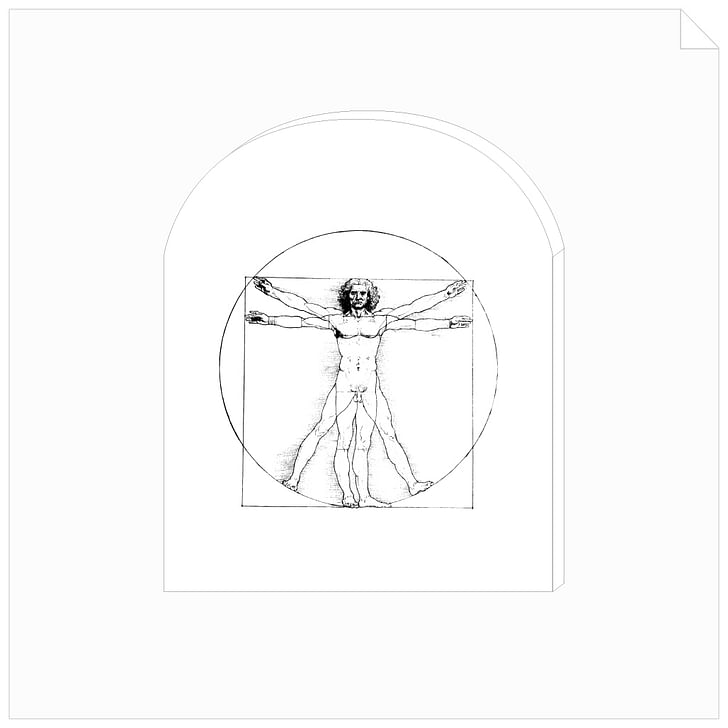
Since at least Vitruvius, architects have searched for rules to live by. After all, when your job is to shape the world we all have to live in, it’s a good idea to make sure you know what you’re doing. But dictates, like the profession itself, need to change with time. So we asked around to find out what today’s architectural “ten commandments” should be. Turns out that, in the 21st century, defining how we practice seems to be more of a concern than establishing rules for what it is we make.

Direction
Laurie Dwyer Ansley
- Listen to the Client. Manifest their words in the design.
- Understand and follow Codes. Never compromise life safety.
- Always remember that I am spending someone else’s money.
- Show respect for and learn from the people who build my projects. Without them it’s just lines on paper.
- Help young architects find their way and BE the example they should follow.
- Don’t judge the architect who wears clogs or Italian leather loafers to a job site. Somewhere there is a roofing nail with their name on it.
- Find that grizzled grumpy curmudgeon detailer in the back corner of the office and learn everything you can from him.
- Listen to the Client. If he or she says they don’t like green, don’t try to convince them that they will like THIS green.
- Bite my tongue when the partner who signs my paycheck says he doesn’t know what that line on the elevation represents, he just knows it wants to be there.
- Keep learning. Not every profession offers unending knowledge and growth. Be glad I chose to be an architect.

Creative Faith
Alexia Virue
Architecture has commanded the attention of 3.6 million architects in today’s world, facing tomorrow’s challenges. They design about twenty percent (20%) of all built structures globally, and drive forward the world of design, and the coordination of progress. Bound with such a career of prestige, of quiet fame, and of worldly intellectual notoriety, endures the inmost optimism. Optimism - that time will bring thought, and that thought will inspire evolution, and evolution will bring progress. With each and every architectural theory and movement, a certain concept has been initialized, and the result desired. In order to plan, in order to scheme, and in order to greatly design, optimism is the driving notion, one that inspires thinking, study, and action into an unspeakable future. The art of design for a known present is gimmick and pattern, but to envision the nature of next generations and impose an intention, is founded on faith.
Faith in architecture has held a perpetual, transparent hand through the physical capabilities of built structure, and the ideology of lasting philosophy. Both the empirical and theoretical realms have constantly merged, to inform conceptual truths throughout architectural discourse. With such evolutions and breakthroughs, have come exemplary models, and rules to the way we scheme as designers. Within the last hundreds of years, Ventruvious wrote the “10 Books of Architecture”, followed by Andrea Palladio’s Four Books of Architecture, during the course of the sixteenth century. More modernly, Le Corbusier awakened modernism with the “Five Points of Architecture”, and very recently Bruco Mau has manifested quite a manifesto in “S,M,L,XL”, alongside the work of Rem Koolhaas.
Like all these historical and established rules, we design for the times in which we plan to live, and the ideas that clearly define such a sensation. For our current era, beyond the “experience-culture” of youth, and the dominance of transience and interactive technology - our rules epitomize our groping faith and experience beyond. And inwardly, whether it be obviously exposed, faith is the the ultimate guiding light to design. And in such a field, I’ve worn all hats. I’ve been a student, a graduate student, a graduate teaching assistant, a research assistant, an intern - multiple times, a thesis award-winner, a carpenter, and now embarking upon architectural licensure. Every bit of these words, every bit of novel ideas - some coming from novels themselves, have kept me inspired. Additionally, life was never easy while doing any other those things above, through all those achievements, and all those successes. It was hard work, and it knowing I was working towards a goal that I didn’t yet know. The hard work was not the curse, but always the blessing. Through all the twists and turns life can take, and it did, architecture was always there, and it made design seem much easier. It was imaging a world that can exist with everything that this world is lacking. Love in architecture is what what kept my faith and sanity, and to showcase the mindfulness behind such a passion, there are rules below to explain it...
(a few more than ten)
- Know yourself.
Your personality and apt for design are inseparable. - The worst of times.
Design is not known for being convenient. The best ideas are often the most ill-timed. - Don’t ever forget your sketchbook.
Let it be your scoreboard for ideas, thoughts, and suggestions that you would never remember. - Always recycle.
Re-using ideas and pieces from older projects and physical models allows for the growth of something better. - Remember.
Hold on to those words of inspiration, that got you through all-nighters, and lit that fire inside of you - you’ll need it. - Theory.
The genius and difficulty of design is to think of the same thing in a way no one else has. - Consciousness of comfort.
Be aware of what makes you a better designer - the clothes, the food, the music - those gimmicks can fill you with the coziness you wish for. - Time matters.
Know the actual amount of time something will take, versus the amount of time you think it will take. - Know a little bit about everything.
Architecture is not a field of just little specific knowledge, so be aware of everything you can learn for your own advantage. - Stay current.
Never lose the spark for using new software, or experimenting with new materials. Keep reading through piles of publications, and stick with those magazine subscriptions. - Purpose.
Figure out your innermost reason for doing the things you do. Deadlines and clients will not make your motivation, but only pressure it. - Studio concept.
Like through school, you should be able to explain your project concisely in sixty seconds or less. One main idea will set off a network of intentions. - Hands of versatility.
Being an architect is more than just “paper architecture.” Direct experience with construction projects, and “using your hands”, can inspire and explain an unimagined aspect of the work you are really doing.

Manifesto etc. and Design Principles
VR
- Do not let the permanence of the built pause the evanescence of architecture.
- Do not be afraid of your own mad voice.
- Beware of the dangers of mass consensus.
- Do not let democracy neutralise the frightful arts.
- Learn to mould subversion into delicate details.
- Never stop searching for expressive disruption.
- Dismantle walls to connect the improbable.
- Build trust structures.
- Believe in creativity but never settle for the absurd.
- Be a pagan.
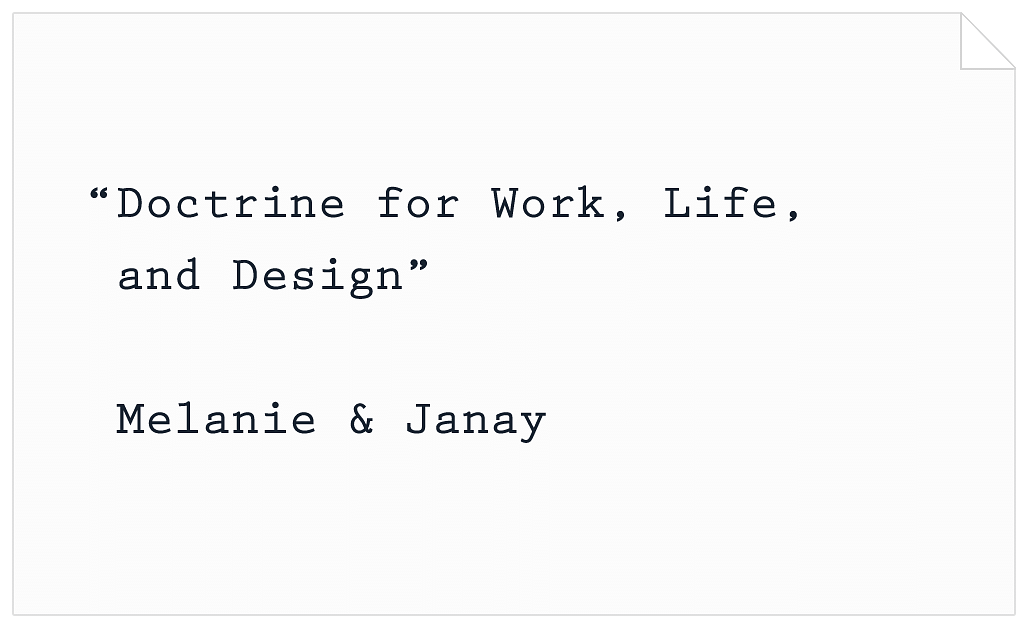

Doctrine for Work, Life, and Design
Melanie & Janay
- Establish excellent standards for yourself. Meet your own expectations, and don’t worry about disappointing others.
- Be open to learning and willing to change your mindset because there’s always more than one path.
- Don’t rush to criticism; witness the beauty in the world because it will guide your work.
- Work is important but only if it has meaning; affirm what is meaningful and reject instant gratification.
- Honor precedence by allowing them to solidify the foundation of character and integrity as those are reliable attributes.
- Don’t dwell on ideas that are distracting; be aware when you need to change course of action.
- Don’t betray your intuition; it’s your beliefs manifest into action, form, and production.
- Everything has already been written, said, or done; the real test of your ability is how you can make these concepts unique.
- Be simplistically honest in your work and character; don’t allow complexity to obscure authenticity.
- Be humble and always help others.

Soli Deo Gloria
Matteo Pistoletti
- You shall not confuse the Holy building with any other beside it.
- You shall not add anything vain.
- You shall not deface it with trade.
- Remember this is God´s Home and Heaven’s Door.
- Honor the builders that came before you.
- You shall not kill the space, the light and the Voice of Subtle Silence.
- You shall not corrupt the building materials.
- You shall not steal ideas, you shall reinvent them.
- You shall not falsify structures, for they are the manifestation of God.
- Let it be welcoming.

Ten rules of a successful architectural practice
Christopher Williams
Every successful architect works hard to listen, partner with clients and deliver projects on time and budget. We are all concerned about our communities and our planet, and strive to show it through our work; otherwise we wouldn’t be here. What defines success beyond these attributes? Vitruvius had his Ten Books. By standing on his shoulders, and those of a few other architectural giants through the ages, CWA has boiled it down to ten rules.
- Listen
Shut up and listen to your client. Get to the heart of the problem, whether that means grasping the challenges inherent in quantum optics research, or discerning the quirks of user behavior. - Prepare
Measure, observe, research and record whatever has the potential to affect design. Take great care. Thoroughness is next to godliness — this is when answers begin to emerge. - Explore
Draw like crazy — cover every scenario, shelving ego and pre-conceived ideas, but always, good or bad, take into account the client’s request. In the end, the best solution will become apparent. - Courage
Express your ideas, no matter how implausible. Trust your instincts, and try not to take yourself too seriously — good ideas are often born in the process of eliminating the bad ones. - Communicate
Use good tools to make sure we are all hearing each other correctly, and seeing the same thing. Could be a narrative, a series of sketches, a model. Could be digital, paper or cardboard, on a diminutive scale or full size. Could be all or any of the above; media is suited to the need. - Teamwork
Tap the best consultants, understand their challenges and direct their participation project-wide. - Translate
Document solutions for construction in a way that leaves nothing to chance. Both to bid and to build, contractors need well-defined documents that help them understand exactly what they’re getting into. Owners need a complete, accurate picture of their project and its costs. - Empathize
There is no substitute for field experience. Valuable mutual learning occurs when designer and builder collaborate. Designers who take the time to understand construction gain a deeper respect for the people and skills involved in moving from blueprint to footprint. We make better buildings as a result. - Nurture
Act like a stakeholder. Follow up long after construction is complete, maintaining relationships forever. Learning from the past informs the future, ultimately to the benefit of all. A true testament of this rule is having repeat clients, the value of which is immeasurable. - Roll With The Punches
Rise above the various forces that are seemingly working against the better interest of the project. Think tact, humor and shared vision. Pick your battles and remind yourself, not every hill is worth dying for.
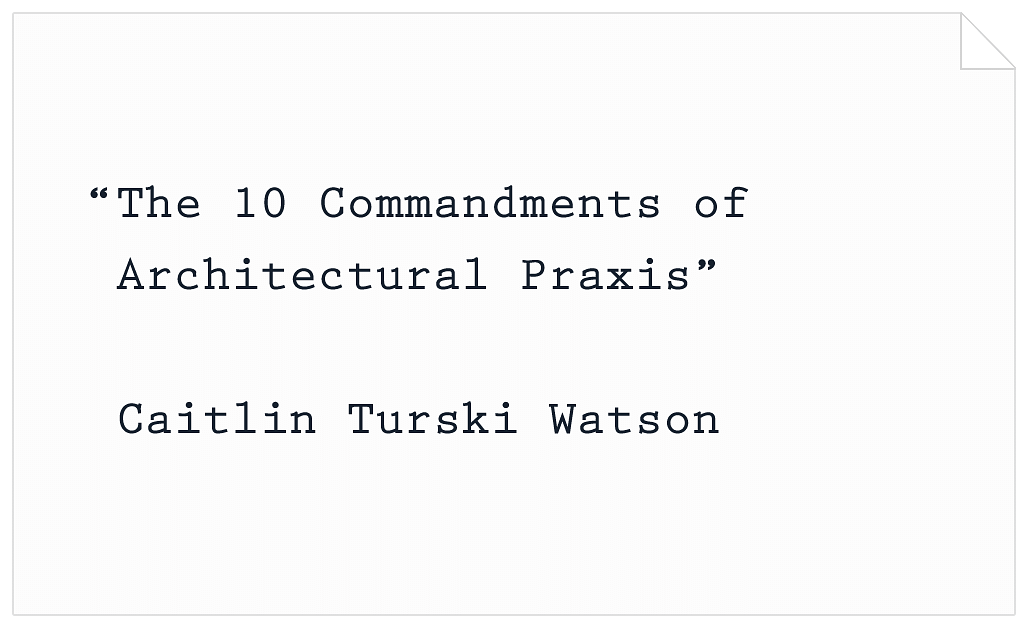
The 10 Commandments of Architectural Praxis
Caitlin Turski Watson
- You are not the sole creator of your work.
- You will not revert to the generation of “cool” forms when the program becomes difficult to negotiate. Every decision should be intentional.
- You will design the void, not the container. Architecture occurs within the space between walls.
- Light and sound are the generators of form. Your task is to bring them together carefully and meaningfully.
- The primary functions of architecture are to provide a space to dwell and to experience wonder.
- You will always put the user before yourself. Your decisions will not be based on profit or marketability.
- You will consider no project complete until it is in use. A building without people in it is not architecture.
- You will ask yourself continually throughout each project whether it is actively improving the community and the lives of the people it serves.
- Your job is not only to build walls, but to help tear them down. It is your duty to create spaces in which all persons are invited with equal dignity and to seek out clients who share this goal.
- You will not settle for the world as it is. Rather, through your work you will strive to imagine it as it might be.
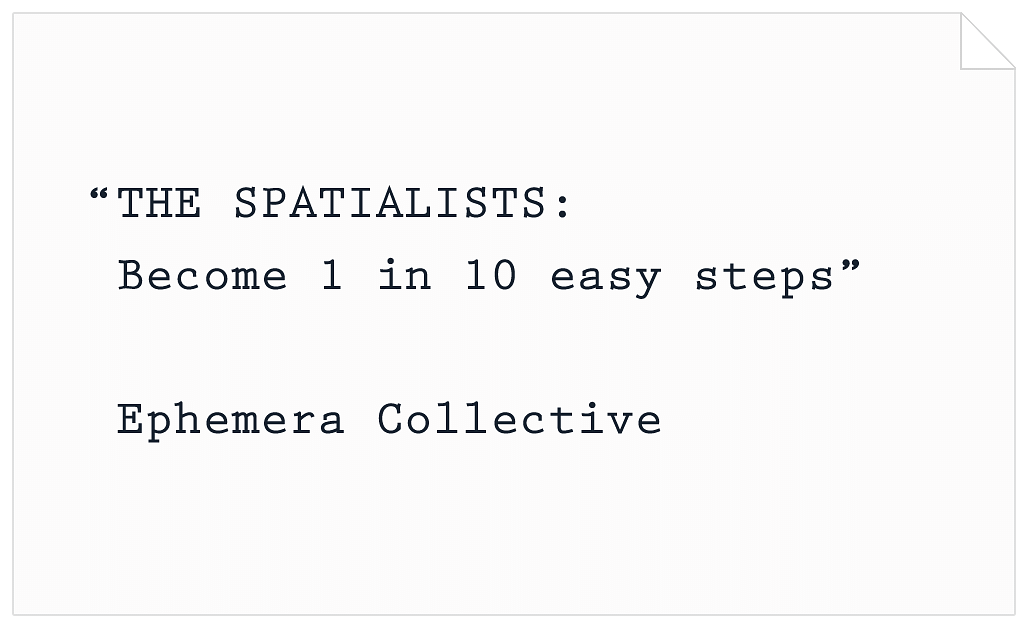
THE SPATIALISTS: Become 1 in 10 easy steps
Ephemera Collective
- You are not an artist. And that is OK.
- Be firmly rooted in your primary discipline.
- Borrow from other disciplines.
- Have criteria! Borrow only what you feel you can use.
- Bring new resources to your primary field.
- Reconnect the theory and the practice.
- Rethink. Requestion. Readjust. Flexibility is the only way to progress.
- Collaborate. But carefully choose your collaborators.
- Be gentle with space: it remembers.
- If you plan on borrowing, quote Godard.

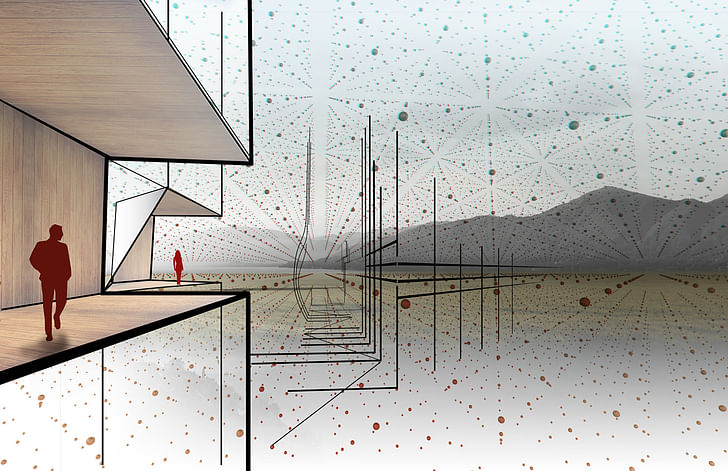
The Charges of Contemporary Architects
Nathan B Strieter
- Above all else a physical manifestation that shapes and encompass space must be the design resolution . Our bodies are physical and require the shelter of a space; space is physical and requires tending lest it fall to ruin.
- Even so the enclosure of any given space is impermanent. Thou must create with thought for the creation's disassembly, not destruction, as to accommodate future generations.
- Creations must inspire the user, viewer and creator to even greater spaces and combinations in the future.
- Thou shall not create false images, for the power of an image can be the power of inspiration but false images lead to hollow architecture.
- Thou shall not create for the novelty of creation. Look to your context and improve an existing system or foster a new system out of neighboring information and patterns.
- Thou shall not waste structural or material capacity. Waste is the enemy of space, and is to be avoided both in the means of creation and the resolution.
- Thou shall not complicate the resolution, nor ornament unnecessarily. Space should have clarity in division, alignment, and detail, as to provide ease of understanding and allow mental repose.
- Remember all scales of perception. Manifestations are not to only be touched, or only to be viewed on handheld screens; they must address both and more.
- Thou shall not recreate history, as a creation is a part of its time. Recreation ignores that buildings must exist in four dimensions not three, and must relate to their time the same way they relate to their metes and bounds.
- Thou shall not blindly accept a client’s resolution, doing so ignores the client’s intention and forsakes better solutions. It is laziness disguised as customer service.













3 Comments
Nicholas, your last couple pieces have been excellent.
A Very Impressive thought provoking article for architects. To Examine one's process and set our what the basic rules should be. I will love to see a follow-up of what others think the ten Commandments should Really be, though it will always be a subjective issue. Well done Nicholas.
This is interesting but it might be more effective to focus on one and give a bit of context, like some accompanying work.
Block this user
Are you sure you want to block this user and hide all related comments throughout the site?
Archinect
This is your first comment on Archinect. Your comment will be visible once approved.